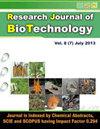胡志明市Can Gio沿海渔业共同管理三个地区浮游动物群落的变化
IF 0.2
Q4 Biochemistry, Genetics and Molecular Biology
引用次数: 0
摘要
浮游动物在水体的食物网中扮演着活的食物来源的角色,决定着许多水生物种的生长和发育,尤其是在幼虫阶段。本研究记录了3个沿海渔业共同管理区28个采样点的29属、21科、6纲、4门、7种幼虫。浮游生物个体的密度在49300个体/立方米至272812个体/立方米之间。Thanh An地区的浮游生物个体数量和密度高于其他地区(Long Hoa和Can Thanh)。浮游动物群落的相似性表明,在40%的采样点,它们被分为两组,如下:第一组为龙华和灿丹共同管理模式区的水体,第二组包括丹安地区的水体。桡足类在采样点中所占比例最高,这表明它将是该生态系统中自然养殖或生活的水生物种生长和发育的丰富食物来源。它也是一个重要的生物因素,需要加以管理和保护,为该地区鱼类种群的可持续性创造一个自然栖息地。本文章由计算机程序翻译,如有差异,请以英文原文为准。
The change of zooplankton communities in three areas for co-management of coastal fisheries in Can Gio, Ho Chi Minh City
Zooplankton plays a role as a living food source in the food web of water bodies, determining the growth and development of many aquatic species, especially at the larval stage. The study has recorded 52 species of 29 genera, 21 families, 6 classes, 4 phylum and 7 types of larvae in 28 sampling sites of 3 areas for co-management of coastal fisheries. The density of plankton individuals ranged from 49300 individuals/m3 to 272812 individuals/ m3. The number of species and density of plankton individuals in Thanh An area is higher than in the other areas (Long Hoa and Can Thanh). The similarity of the zooplankton communities showed that at 40% of the sampling sites, they were divided into 2 groups as follows: group 1 of water bodies in the co-management model area in Long Hoa and Can Thanh, group 2 included the water bodies of Thanh An area. The Copepoda class is the highest proportion in the sampling sites, showing that it will be an abundant food source for the growth and development of aquatic species that are cultured or live naturally in this ecosystem. It is also an important biological factor that needs to be managed and conserved to create a natural habitat for the sustainability of fish stocks in the area.
求助全文
通过发布文献求助,成功后即可免费获取论文全文。
去求助
来源期刊

Research Journal of Biotechnology
工程技术-生物工程与应用微生物
CiteScore
0.60
自引率
0.00%
发文量
192
审稿时长
1.5 months
期刊介绍:
We invite you to contribute Research Papers / Short Communications / Review Papers:
-In any field of Biotechnology, Biochemistry, Microbiology and Industrial Microbiology, Soil Technology, Agriculture Biotechnology.
-in any field related to Food Biotechnology, Nutrition Biotechnology, Genetic Engineering and Commercial Biotechnology.
-in any field of Biotechnology related to Drugs and Pharmaceutical products for human beings, animals and plants.
-in any field related to Environmental Biotechnolgy, Waste Treatment of Liquids, Soilds and Gases; Sustainability.
-in inter-realted field of Chemical Sciences, Biological Sciences, Environmental Sciences and Life Sciences.
-in any field related to Biotechnological Engineering, Industrial Biotechnology and Instrumentation.
-in any field related to Nano-technology.
-in any field related to Plant Biotechnology.
 求助内容:
求助内容: 应助结果提醒方式:
应助结果提醒方式:


